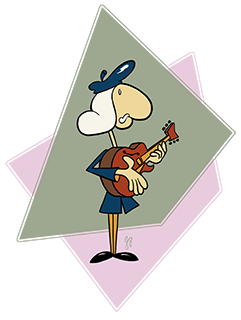| brunoinversions.pdf |
Jimmy Bruno starts his chord teaching with the dominant 7 voicings on strings 6-4-3-2. Learn to play the leftmost column top to bottom on page 1 of the PDF in sequence. Start with the top-most voicing starting with the "C" on the second string. Find the next voicing in the column by finding the next root up the fretboard. The red "R" spots where the root of the voicing lands. Play first column sequence in all twelve keys, going in fourths (C, F, Bb, Eb, etc.). You won't play chords for the roots that are on strings 5 and 1 for this exercise. For each shape, learn what each note is in terms of its interval -- b7, 3, 5, root.
Lesson 2
Now go down the second column. This group is called '4321.' You are just putting the note on the sixth string from the 6432 group on the first string for the 4321 group. Land the voicings on all the roots up the neck for this column, skipping roots that are on strings 5 and 6 this time. Learn in all 12 keys, moving in the cycle of fourths. Make sure you can play them down the neck, too.
Lesson 3
The next group is 5432. You are taking the same shape you started with in 4321, except moving the note on the G-string to account for the B-string shift. Find the voicings all the way up the neck, skipping roots that are on strings 6 and 1 this time. The shapes will go in the same order. Learn in all 12 keys. Make sure you understand where the intervals are in each voicing.
Lesson 4
Now move the voicings up to strings 6543. Again you have to shift to account for what was on the B-string. Find the voicings on the all the roots, not including those on strings 2 and 1. Play down the column, learning the inversions in all 12 keys going by the circle of fourths.
Lesson 5
Now move the 6432 voicing to 5321. The shapes alter because of the B-string. Find the first voicing in F. The next F is on the 4th string, which we aren't playing. Find the next F on the second string and use the second voicing down in the leftmost column. Play down this last column until you can change fingerings fluidly. Play them in all twelve keys with the circle of fourths, up and down the neck.
Lesson 6
Now refer to the 6432 voicings you learned in Lesson 1. In each one, find the third and flatten it (move down a half-step). These are your minor 7 voicings in 6432, shown on page two. Flatten the third on all the string groupings to learn minor 7 chords on 6432, 4321, 5432, 6543, 5321. Play them in sequence up the neck and then learn them down the neck. Play them in all keys, moving in fourths.
Lesson 7
The Major 7 inversions are learned the same way. Start with the dominant shapes and, for each one, find the flat 7 and move it up a half step. These are all on page 3. Learn all these intervals the same way, so you can fluidly move to the next shape up and down in all keys in the circle of fourths.
Lesson 8
Next comes the Min7b5 or half-diminished. Take each Minor 7 shape you learned and flatten the 5 by moving it down a half-step. Learn them column by column like the other chord types.
Lesson 9
Now you can start putting the chords to work. Start with the ii-V progression on page 5. Play the minor 7 chord (ii) and then the dominant 7 chord (V). Then repeat the progression with the shapes in row 2. Play all these progressions up and down the neck in all 12 keys as well.
Lesson 10
Finally, add a Major 7 chord to resolve the progressions you learned in lesson 9. Play the minor 7 (ii) for one bar, then the dominant 7 (V) for a bar, then the major 7 (I) for two bars. Move to the next row and repeat with these shapes. These progressions feature good voice leading. This means that one of the notes moves in a scale-like fashion with many of the other notes staying in place. This emphasizes a sequential movement to emphasize harmonic changes of the chords. Good voice-leading changes the chords while staying "melodic." You will have to transpose these chords to play them in all twelve keys, but the transitions will all be the same for this exercise. The ii-V-I listed is in C. After you do them all in C, do them all where the I chord is Fmaj7 (G-7 / C7 / Fmaj7 / Fmaj7). Next will come the key of Bb, where the I chord is Bbmaj7. Keep repeating in fourths until you've played the progressions in all 12 keys.

 RSS Feed
RSS Feed
